Deck 4: The Three-Dimensional Structure of Proteins
Question
Question
Question
Question
Question
Question
Question
Question
Question
Question
Question
Question
Question
Question
Question
Question
Question
Question
Question
Question
Question
Question
Question
Question
Question
Question
Question
Question
Question
Question
Question
Question
Question
Question
Question
Question
Question
Question
Question
Question
Question
Question
Question
Question
Question
Question
Question
Question
Question
Question
Question
Question
Question
Question
Question
Question
Question
Question
Question
Question
Question
Question
Question
Question
Question
Question
Question
Question
Question
Question
Question
Question
Question
Question
Question
Question
Question

Unlock Deck
Sign up to unlock the cards in this deck!
Unlock Deck
Unlock Deck
1/77
Play
Full screen (f)
Deck 4: The Three-Dimensional Structure of Proteins
1
A single amino substitution can give rise to a malfunctioning protein.
True
2
Which of the following forces are involved in maintaining the primary structure of a protein?
A) covalent bonds
B) hydrogen bonds
C) ionic interactions
D) hydrophobic interactions
A) covalent bonds
B) hydrogen bonds
C) ionic interactions
D) hydrophobic interactions
A
3
Covalent bonds are important in all these structures,except:
A) primary structure
B) secondary structure
C) tertiary structure
D) quaternary structure
E) All of these
A) primary structure
B) secondary structure
C) tertiary structure
D) quaternary structure
E) All of these
D
4
Which of the following best describes the structure of collagen?
A) It is composed of a single a-helix.
B) It is a double helix.
C) It is a triple helix
D) It is composed primarily of b-sheet.
A) It is composed of a single a-helix.
B) It is a double helix.
C) It is a triple helix
D) It is composed primarily of b-sheet.

Unlock Deck
Unlock for access to all 77 flashcards in this deck.
Unlock Deck
k this deck
5
Structures which repeat over and over in secondary structure are called:
A) primary structure
B) domain
C) supersecondary structure
D) prosthetic group
E) All of these
A) primary structure
B) domain
C) supersecondary structure
D) prosthetic group
E) All of these

Unlock Deck
Unlock for access to all 77 flashcards in this deck.
Unlock Deck
k this deck
6
Exhibit 4A The following question(s) refer to this peptide:
Cys-Ala-Gly-Arg-Gln-Met
Refer to Exhibit 4A.The carboxyl terminal end is:
A) Arg
B) Cys
C) Gln
D) Met
E) None of these.
Cys-Ala-Gly-Arg-Gln-Met
Refer to Exhibit 4A.The carboxyl terminal end is:
A) Arg
B) Cys
C) Gln
D) Met
E) None of these.

Unlock Deck
Unlock for access to all 77 flashcards in this deck.
Unlock Deck
k this deck
7
Exhibit 4A The following question(s) refer to this peptide:
Cys-Ala-Gly-Arg-Gln-Met
Refer to Exhibit 4A.The overall,net ionic charge on this peptide at pH = 7 would be:
A) +2
B) +1
C) 0
D) -1
E) -2
Cys-Ala-Gly-Arg-Gln-Met
Refer to Exhibit 4A.The overall,net ionic charge on this peptide at pH = 7 would be:
A) +2
B) +1
C) 0
D) -1
E) -2

Unlock Deck
Unlock for access to all 77 flashcards in this deck.
Unlock Deck
k this deck
8
Which of the following statements regarding hydrogen bonding in secondary structures is true?
A) Both a-helices and b-sheets only use intrachain hydrogen bonds.
B) Both a-helices and b-sheets only use interchain hydrogen bonds.
C) a-helices only use intrachain hydrogen bonds and b-sheets can use either intrachain or interchain hydrogen bonds.
D) a-helices can use either intrachain or interchain hydrogen bonds and b-sheets only use interchain hydrogen bonds.
A) Both a-helices and b-sheets only use intrachain hydrogen bonds.
B) Both a-helices and b-sheets only use interchain hydrogen bonds.
C) a-helices only use intrachain hydrogen bonds and b-sheets can use either intrachain or interchain hydrogen bonds.
D) a-helices can use either intrachain or interchain hydrogen bonds and b-sheets only use interchain hydrogen bonds.

Unlock Deck
Unlock for access to all 77 flashcards in this deck.
Unlock Deck
k this deck
9
Disulfide bonds are most important in this type of structure:
A) primary structure
B) secondary structure
C) tertiary structure
D) quaternary structure
E) All of these
A) primary structure
B) secondary structure
C) tertiary structure
D) quaternary structure
E) All of these

Unlock Deck
Unlock for access to all 77 flashcards in this deck.
Unlock Deck
k this deck
10
Exhibit 4A The following question(s) refer to this peptide:
Cys-Ala-Gly-Arg-Gln-Met
Refer to Exhibit 4A.Total hydrolysis of the peptide in HCl would yield these products:
A) Ala, Arg, Cys, Gln, Gly, Met
B) Ala, Arg, 2 Cys, Gln, Gly, H2S
C) Ala, Arg, Cys, Glu, Gly, Met, NH3
D) Ala, Arg, 2 Cys, Glu, Gly, H2S, NH3
E) None of these answers is correct.
Cys-Ala-Gly-Arg-Gln-Met
Refer to Exhibit 4A.Total hydrolysis of the peptide in HCl would yield these products:
A) Ala, Arg, Cys, Gln, Gly, Met
B) Ala, Arg, 2 Cys, Gln, Gly, H2S
C) Ala, Arg, Cys, Glu, Gly, Met, NH3
D) Ala, Arg, 2 Cys, Glu, Gly, H2S, NH3
E) None of these answers is correct.

Unlock Deck
Unlock for access to all 77 flashcards in this deck.
Unlock Deck
k this deck
11
Exhibit 4A The following question(s) refer to this peptide:
Cys-Ala-Gly-Arg-Gln-Met
Refer to Exhibit 4A.The amino terminal amino acid is:
A) Arg
B) Cys
C) Gln
D) Met
E) None of these.
Cys-Ala-Gly-Arg-Gln-Met
Refer to Exhibit 4A.The amino terminal amino acid is:
A) Arg
B) Cys
C) Gln
D) Met
E) None of these.

Unlock Deck
Unlock for access to all 77 flashcards in this deck.
Unlock Deck
k this deck
12
What happens when a protein is denatured?
A) Its secondary structure is disrupted but its primary structure remains intact.
B) Its primary structure is disrupted but its secondary structure remains intact.
C) It is broken apart into its constituent amino acids.
D) It becomes all a-helix.
A) Its secondary structure is disrupted but its primary structure remains intact.
B) Its primary structure is disrupted but its secondary structure remains intact.
C) It is broken apart into its constituent amino acids.
D) It becomes all a-helix.

Unlock Deck
Unlock for access to all 77 flashcards in this deck.
Unlock Deck
k this deck
13
Which of the following amino acids is unlikely to be found in an a-helix due to its cyclic structure?
A) phenylalanine
B) tryptophan
C) proline
D) lysine
A) phenylalanine
B) tryptophan
C) proline
D) lysine

Unlock Deck
Unlock for access to all 77 flashcards in this deck.
Unlock Deck
k this deck
14
Which of the following factors tend to destabilize a-helices?
A) clusters of amino acids with bulky R-groups
B) clusters of amino acids with similarly charged R-groups
C) Both of these.
D) Neither of these
A) clusters of amino acids with bulky R-groups
B) clusters of amino acids with similarly charged R-groups
C) Both of these.
D) Neither of these

Unlock Deck
Unlock for access to all 77 flashcards in this deck.
Unlock Deck
k this deck
15
Which of the following best defines a domain?
A) A supersecondary region, often shared by proteins, that has a specific function.
B) A repetitive supersecondary structure.
C) A double-layered arrangement formed so that the polar groups face the aqueous environment, while the nonpolar regions are kept away from the aqueous environment.
D) An unfolded region of a protein.
A) A supersecondary region, often shared by proteins, that has a specific function.
B) A repetitive supersecondary structure.
C) A double-layered arrangement formed so that the polar groups face the aqueous environment, while the nonpolar regions are kept away from the aqueous environment.
D) An unfolded region of a protein.

Unlock Deck
Unlock for access to all 77 flashcards in this deck.
Unlock Deck
k this deck
16
Assuming the oligopeptide ALPHAHELICKS forms one continuous a-helix,the carbonyl oxygen of the glutamic acid residue is hydrogen bonded to the amide nitrogen of
A) leucine.
B) isoleucine.
C) cysteine.
D) lysine.
E) serine.
A) leucine.
B) isoleucine.
C) cysteine.
D) lysine.
E) serine.

Unlock Deck
Unlock for access to all 77 flashcards in this deck.
Unlock Deck
k this deck
17
Hydrogen bonds are most important in this type of structure in proteins:
A) primary structure
B) secondary structure
C) tertiary structure
D) quaternary structure
E) All of these
A) primary structure
B) secondary structure
C) tertiary structure
D) quaternary structure
E) All of these

Unlock Deck
Unlock for access to all 77 flashcards in this deck.
Unlock Deck
k this deck
18
The overall folding of a single protein subunit is called:
A) primary structure
B) secondary structure
C) tertiary structure
D) quaternary structure
E) All of these
A) primary structure
B) secondary structure
C) tertiary structure
D) quaternary structure
E) All of these

Unlock Deck
Unlock for access to all 77 flashcards in this deck.
Unlock Deck
k this deck
19
The sequence of monomers in any polymer is this type of structure:
A) primary structure
B) secondary structure
C) tertiary structure
D) quaternary structure
E) All of these
A) primary structure
B) secondary structure
C) tertiary structure
D) quaternary structure
E) All of these

Unlock Deck
Unlock for access to all 77 flashcards in this deck.
Unlock Deck
k this deck
20
The location of prosthetic groups is shown in this level of structure:
A) primary structure
B) secondary structure
C) tertiary structure
D) quaternary structure
E) All of these
A) primary structure
B) secondary structure
C) tertiary structure
D) quaternary structure
E) All of these

Unlock Deck
Unlock for access to all 77 flashcards in this deck.
Unlock Deck
k this deck
21
In the b-pleated sheet conformation
A) there are hydrogen bonds perpendicular to the direction of the polypeptide chain.
B) the polypeptide chain is almost fully extended.
C) the polypeptide chains may be hydrogen bonded together in a parallel or antiparallel orientation.
D) all of these
A) there are hydrogen bonds perpendicular to the direction of the polypeptide chain.
B) the polypeptide chain is almost fully extended.
C) the polypeptide chains may be hydrogen bonded together in a parallel or antiparallel orientation.
D) all of these

Unlock Deck
Unlock for access to all 77 flashcards in this deck.
Unlock Deck
k this deck
22
Generally speaking,this type of protein is water-soluble:
A) Fibrous.
B) Globular.
C) Both fibrous and globular proteins are usually water-soluble.
D) Neither fibrous nor globular proteins are usually water-soluble.
E) You cannot generalize about the solubility of fibrous or globular proteins.
A) Fibrous.
B) Globular.
C) Both fibrous and globular proteins are usually water-soluble.
D) Neither fibrous nor globular proteins are usually water-soluble.
E) You cannot generalize about the solubility of fibrous or globular proteins.

Unlock Deck
Unlock for access to all 77 flashcards in this deck.
Unlock Deck
k this deck
23
Exhibit 4B 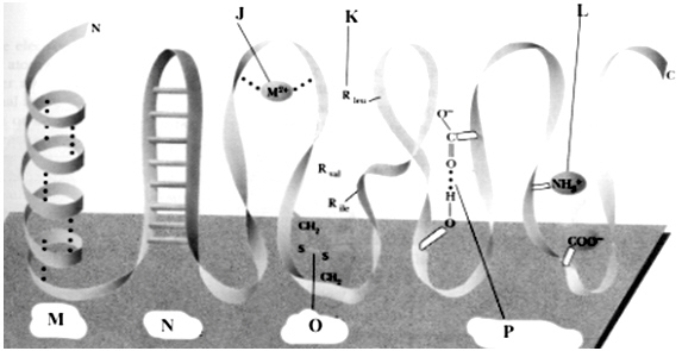 Refer to Exhibit 4B.The type of bonding labeled "L" in these figure is:
Refer to Exhibit 4B.The type of bonding labeled "L" in these figure is:
A) Hydrogen bonding of the peptide backbone
B) Hydrogen bonding involving the R-groups
C) Hydrophobic interactions
D) Metal ion coordination
E) Electrostatic attraction
 Refer to Exhibit 4B.The type of bonding labeled "L" in these figure is:
Refer to Exhibit 4B.The type of bonding labeled "L" in these figure is:A) Hydrogen bonding of the peptide backbone
B) Hydrogen bonding involving the R-groups
C) Hydrophobic interactions
D) Metal ion coordination
E) Electrostatic attraction

Unlock Deck
Unlock for access to all 77 flashcards in this deck.
Unlock Deck
k this deck
24
The protein myoglobin
A) contains a high degree of b-pleated sheet structure
B) carries oxygen in the bloodstream
C) contains no histidine
D) contains a heme group
A) contains a high degree of b-pleated sheet structure
B) carries oxygen in the bloodstream
C) contains no histidine
D) contains a heme group

Unlock Deck
Unlock for access to all 77 flashcards in this deck.
Unlock Deck
k this deck
25
Which of the following is true?
A) The peptide bonds in the b-sheet are extended.
B) The peptide bonds in the a-helix coil back on themselves.
C) Both a-helices and b-sheets can be found as part of tertiary structure.
D) All of these
A) The peptide bonds in the b-sheet are extended.
B) The peptide bonds in the a-helix coil back on themselves.
C) Both a-helices and b-sheets can be found as part of tertiary structure.
D) All of these

Unlock Deck
Unlock for access to all 77 flashcards in this deck.
Unlock Deck
k this deck
26
Vitamin C (ascorbic acid) prevents scurvy because
A) it is involved in the formation of the proper b-sheet structure of collagen.
B) it is involved in the metabolism of heme used in hemoglobin.
C) it encourages the formation of disulfide linkages in collagen.
D) it is an unusual amino acid found in the primary structure of collagen.
E) it is used to hydroxylate prolines in the primary structure of collagen.
A) it is involved in the formation of the proper b-sheet structure of collagen.
B) it is involved in the metabolism of heme used in hemoglobin.
C) it encourages the formation of disulfide linkages in collagen.
D) it is an unusual amino acid found in the primary structure of collagen.
E) it is used to hydroxylate prolines in the primary structure of collagen.

Unlock Deck
Unlock for access to all 77 flashcards in this deck.
Unlock Deck
k this deck
27
Fibrous proteins
A) are always composed of helical structures.
B) are always composed of b-sheets.
C) can be composed of either helical or b-sheet structures.
A) are always composed of helical structures.
B) are always composed of b-sheets.
C) can be composed of either helical or b-sheet structures.

Unlock Deck
Unlock for access to all 77 flashcards in this deck.
Unlock Deck
k this deck
28
In the a-helix
A) there are no hydrogen bonds
B) the peptide chain is fully extended
C) the peptide chain bends back on itself
D) there are hydrogen bonds parallel to the helix axis
A) there are no hydrogen bonds
B) the peptide chain is fully extended
C) the peptide chain bends back on itself
D) there are hydrogen bonds parallel to the helix axis

Unlock Deck
Unlock for access to all 77 flashcards in this deck.
Unlock Deck
k this deck
29
Domains are
A) independently folded regions of proteins
B) the a-helical portions of proteins
C) the b-pleated regions of proteins
D) all of the above
A) independently folded regions of proteins
B) the a-helical portions of proteins
C) the b-pleated regions of proteins
D) all of the above

Unlock Deck
Unlock for access to all 77 flashcards in this deck.
Unlock Deck
k this deck
30
The following is true about the hydroxyproline in collagen:
A) Hydroxyproline is incorporated into the chain during polymerization of amino acids.
B) Vitamin C is necessary for the synthesis of hydroxyproline.
C) Hydroxyproline is important in holding the 3 strands of collagen together.
D) Hydroxyproline requires Vitamin C for its synthesis and it holds the collagen helix together.
E) All of these.
A) Hydroxyproline is incorporated into the chain during polymerization of amino acids.
B) Vitamin C is necessary for the synthesis of hydroxyproline.
C) Hydroxyproline is important in holding the 3 strands of collagen together.
D) Hydroxyproline requires Vitamin C for its synthesis and it holds the collagen helix together.
E) All of these.

Unlock Deck
Unlock for access to all 77 flashcards in this deck.
Unlock Deck
k this deck
31
Exhibit 4B 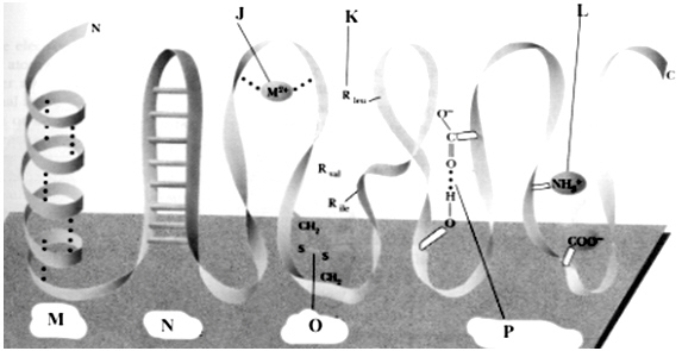 Refer to Exhibit 4B.The type of bonding labeled "O" in these figure is:
Refer to Exhibit 4B.The type of bonding labeled "O" in these figure is:
A) Hydrogen bonding of the peptide backbone
B) Covalent bonding involving the R-groups
C) Hydrophobic interactions
D) Metal ion coordination
E) Electrostatic attraction
 Refer to Exhibit 4B.The type of bonding labeled "O" in these figure is:
Refer to Exhibit 4B.The type of bonding labeled "O" in these figure is:A) Hydrogen bonding of the peptide backbone
B) Covalent bonding involving the R-groups
C) Hydrophobic interactions
D) Metal ion coordination
E) Electrostatic attraction

Unlock Deck
Unlock for access to all 77 flashcards in this deck.
Unlock Deck
k this deck
32
Which of the following amino acid residues would most likely be found in the interior of a globular protein?
A) glutamic acid
B) lysine
C) leucine
D) serine
A) glutamic acid
B) lysine
C) leucine
D) serine

Unlock Deck
Unlock for access to all 77 flashcards in this deck.
Unlock Deck
k this deck
33
Which of the following is true?
A) The collagen helix and the a-helix are the only types of helices in proteins.
B) Globular proteins tend to be water soluble
C) Globular and fibrous are examples of secondary structure
D) All of these
A) The collagen helix and the a-helix are the only types of helices in proteins.
B) Globular proteins tend to be water soluble
C) Globular and fibrous are examples of secondary structure
D) All of these

Unlock Deck
Unlock for access to all 77 flashcards in this deck.
Unlock Deck
k this deck
34
Disulfide bonds in proteins occur between the side chains of which of the following amino acid residues?
A) glutamine
B) lysine
C) cysteine
D) methionine
A) glutamine
B) lysine
C) cysteine
D) methionine

Unlock Deck
Unlock for access to all 77 flashcards in this deck.
Unlock Deck
k this deck
35
Which of the following best describes a motif?
A) a repetitive supersecondary structure
B) a common nonrepetitive irregularity found in antiparallel b-sheets
C) a protein conformation with biological activity
D) a group of atoms other than an amino acid
A) a repetitive supersecondary structure
B) a common nonrepetitive irregularity found in antiparallel b-sheets
C) a protein conformation with biological activity
D) a group of atoms other than an amino acid

Unlock Deck
Unlock for access to all 77 flashcards in this deck.
Unlock Deck
k this deck
36
Which one is not an example of supersecondary structure?
A) the pyrrole ring
B) the Greek key
C) the b-meander
D) the b-barrel
A) the pyrrole ring
B) the Greek key
C) the b-meander
D) the b-barrel

Unlock Deck
Unlock for access to all 77 flashcards in this deck.
Unlock Deck
k this deck
37
As an animal ages,the amount of cross-linking of collagen in tissue
A) tends to decrease.
B) tends to increase.
C) tends to remain unchanged.
A) tends to decrease.
B) tends to increase.
C) tends to remain unchanged.

Unlock Deck
Unlock for access to all 77 flashcards in this deck.
Unlock Deck
k this deck
38
Which of the following is often found connecting the strands of an antiparallel b-sheet?
A) b-bulge
B) reverse turn
C) a-helix
D) prosthetic group
A) b-bulge
B) reverse turn
C) a-helix
D) prosthetic group

Unlock Deck
Unlock for access to all 77 flashcards in this deck.
Unlock Deck
k this deck
39
Which of the following is the most common function for fibrous proteins?
A) enzymes
B) structural roles.
C) carrier molecules.
D) enzymes and carrier molecules.
E) All of these.
A) enzymes
B) structural roles.
C) carrier molecules.
D) enzymes and carrier molecules.
E) All of these.

Unlock Deck
Unlock for access to all 77 flashcards in this deck.
Unlock Deck
k this deck
40
Two amino acids frequently found in reverse turns are
A) tyrosine and tryptophan
B) serine and threonine
C) glycine and proline
D) leucine and isoleucine
A) tyrosine and tryptophan
B) serine and threonine
C) glycine and proline
D) leucine and isoleucine

Unlock Deck
Unlock for access to all 77 flashcards in this deck.
Unlock Deck
k this deck
41
The following bond forces are important in quaternary structure:
A) Disulfide bonds
B) Hydrogen bonds
C) Hydrophobic attraction
D) Both hydrogen bonds and hydrophobic attraction.
E) All of these are important in quaternary structure.
A) Disulfide bonds
B) Hydrogen bonds
C) Hydrophobic attraction
D) Both hydrogen bonds and hydrophobic attraction.
E) All of these are important in quaternary structure.

Unlock Deck
Unlock for access to all 77 flashcards in this deck.
Unlock Deck
k this deck
42
Which of the following statements regarding hemoglobin (Hb) and myoglobin (Mb) is true?
A) Mb transports oxygen while Hb stores it.
B) Mb has quaternary structure but Hb does not.
C) Mb displays simple kinetics of binding while Hb displays cooperativity.
D) Mb binds Fe(II) while Hb binds heme.
A) Mb transports oxygen while Hb stores it.
B) Mb has quaternary structure but Hb does not.
C) Mb displays simple kinetics of binding while Hb displays cooperativity.
D) Mb binds Fe(II) while Hb binds heme.

Unlock Deck
Unlock for access to all 77 flashcards in this deck.
Unlock Deck
k this deck
43
The following bond forces are important in tertiary structure:
A) Disulfide bonds
B) Hydrogen bonds
C) Hydrophobic attraction
D) Both hydrogen bonds and hydrophobic attraction.
E) All of these are important in tertiary structure
A) Disulfide bonds
B) Hydrogen bonds
C) Hydrophobic attraction
D) Both hydrogen bonds and hydrophobic attraction.
E) All of these are important in tertiary structure

Unlock Deck
Unlock for access to all 77 flashcards in this deck.
Unlock Deck
k this deck
44
In what oxidation state must the iron atom be for heme to bind oxygen?
A) 0, Fe(0)
B) 1+, Fe(I)
C) 2+, Fe(II)
D) 3+, Fe(III)
E) There is no required oxidation state for the iron.
A) 0, Fe(0)
B) 1+, Fe(I)
C) 2+, Fe(II)
D) 3+, Fe(III)
E) There is no required oxidation state for the iron.

Unlock Deck
Unlock for access to all 77 flashcards in this deck.
Unlock Deck
k this deck
45
The structure of myoglobin consists
A) almost entirely of a-helices.
B) almost entirely of b-sheets.
C) of a mixture of a-helices and b-sheets.
D) of a unique secondary motif that is neither a-helix nor b-sheet.
A) almost entirely of a-helices.
B) almost entirely of b-sheets.
C) of a mixture of a-helices and b-sheets.
D) of a unique secondary motif that is neither a-helix nor b-sheet.

Unlock Deck
Unlock for access to all 77 flashcards in this deck.
Unlock Deck
k this deck
46
Under normal circumstances:
A) Adult Hb binds to oxygen more tightly than Mb binds.
B) Fetal Hb binds oxygen more tightly than adult Hb.
C) Adult Hb binds oxygen more tightly than either fetal Hb or Mb binds.
D) Mb has the lowest affinity for oxygen of the 3.
E) More than one of these statements is correct.
A) Adult Hb binds to oxygen more tightly than Mb binds.
B) Fetal Hb binds oxygen more tightly than adult Hb.
C) Adult Hb binds oxygen more tightly than either fetal Hb or Mb binds.
D) Mb has the lowest affinity for oxygen of the 3.
E) More than one of these statements is correct.

Unlock Deck
Unlock for access to all 77 flashcards in this deck.
Unlock Deck
k this deck
47
Exhibit 4B 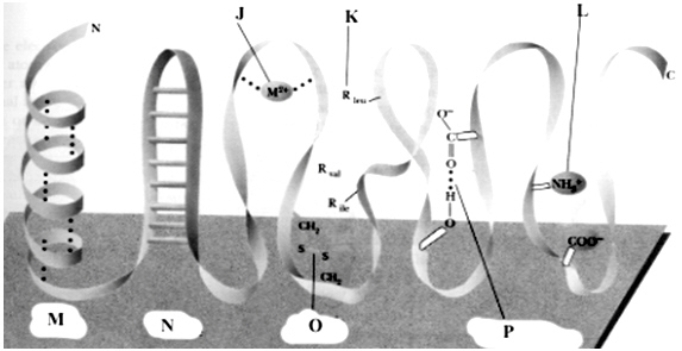 Refer to Exhibit 4B.Which one shows hydrogen bonding of the peptide backbone?
Refer to Exhibit 4B.Which one shows hydrogen bonding of the peptide backbone?
A) M
B) N
C) P
D) M and N
E) All of these
 Refer to Exhibit 4B.Which one shows hydrogen bonding of the peptide backbone?
Refer to Exhibit 4B.Which one shows hydrogen bonding of the peptide backbone?A) M
B) N
C) P
D) M and N
E) All of these

Unlock Deck
Unlock for access to all 77 flashcards in this deck.
Unlock Deck
k this deck
48
Exhibit 4B 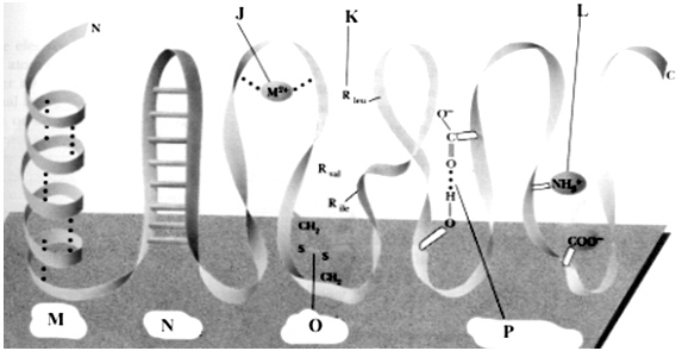 Refer to Exhibit 4B.The type of bonding labeled "N" in these figure is:
Refer to Exhibit 4B.The type of bonding labeled "N" in these figure is:
A) Hydrogen bonding of the peptide backbone
B) Covalent bonding involving the R-groups
C) Hydrophobic interactions
D) Metal ion coordination
E) Electrostatic attraction
 Refer to Exhibit 4B.The type of bonding labeled "N" in these figure is:
Refer to Exhibit 4B.The type of bonding labeled "N" in these figure is:A) Hydrogen bonding of the peptide backbone
B) Covalent bonding involving the R-groups
C) Hydrophobic interactions
D) Metal ion coordination
E) Electrostatic attraction

Unlock Deck
Unlock for access to all 77 flashcards in this deck.
Unlock Deck
k this deck
49
Which of the following forces are involved in maintaining the quaternary structure of a protein?
A) hydrogen bonds
B) ionic interactions
C) hydrophobic interactions
D) All of these
A) hydrogen bonds
B) ionic interactions
C) hydrophobic interactions
D) All of these

Unlock Deck
Unlock for access to all 77 flashcards in this deck.
Unlock Deck
k this deck
50
Exhibit 4B 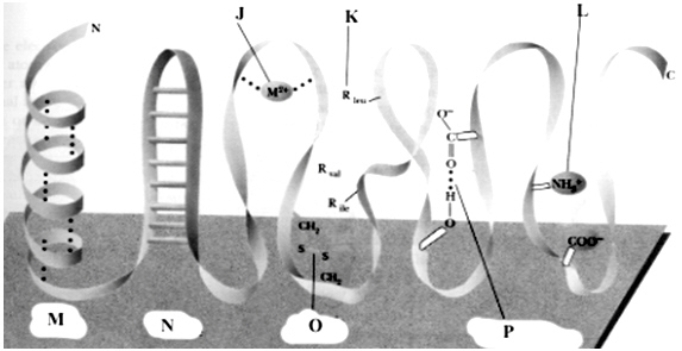 Refer to Exhibit 4B.Which one shows hydrogen bonding of R-groups?
Refer to Exhibit 4B.Which one shows hydrogen bonding of R-groups?
A) M
B) N
C) P
D) M and N
E) All of these
 Refer to Exhibit 4B.Which one shows hydrogen bonding of R-groups?
Refer to Exhibit 4B.Which one shows hydrogen bonding of R-groups?A) M
B) N
C) P
D) M and N
E) All of these

Unlock Deck
Unlock for access to all 77 flashcards in this deck.
Unlock Deck
k this deck
51
Exhibit 4B 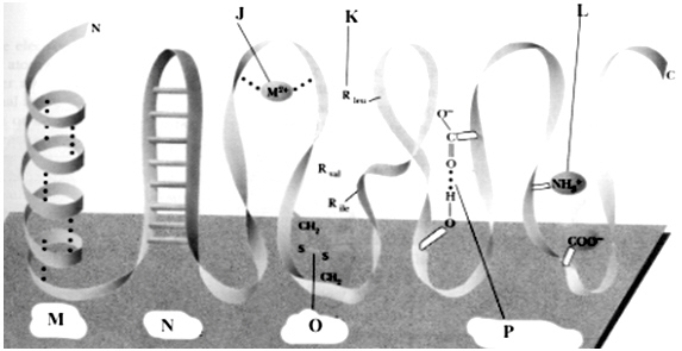 Refer to Exhibit 4B.Which one shows electrostatic attraction of R-groups?
Refer to Exhibit 4B.Which one shows electrostatic attraction of R-groups?
A) K
B) L
C) O
D) K and L
E) All of these
 Refer to Exhibit 4B.Which one shows electrostatic attraction of R-groups?
Refer to Exhibit 4B.Which one shows electrostatic attraction of R-groups?A) K
B) L
C) O
D) K and L
E) All of these

Unlock Deck
Unlock for access to all 77 flashcards in this deck.
Unlock Deck
k this deck
52
Which of the following is not a characteristic of hemoglobin?
A) It contains two different types of subunits .
B) It contains a prosthetic group.
C) It is an allosteric enzyme.
D) It transports oxygen.
E) All of these statements are true for Hb.
A) It contains two different types of subunits .
B) It contains a prosthetic group.
C) It is an allosteric enzyme.
D) It transports oxygen.
E) All of these statements are true for Hb.

Unlock Deck
Unlock for access to all 77 flashcards in this deck.
Unlock Deck
k this deck
53
Quaternary structure is associated with
A) the overall shape of the polypeptide chain
B) the sum of secondary and tertiary interactions
C) simple proteins with only one subunit
D) the relative orientation of one polypeptide to another polypeptide in a multisubunit protein
A) the overall shape of the polypeptide chain
B) the sum of secondary and tertiary interactions
C) simple proteins with only one subunit
D) the relative orientation of one polypeptide to another polypeptide in a multisubunit protein

Unlock Deck
Unlock for access to all 77 flashcards in this deck.
Unlock Deck
k this deck
54
The tertiary structure of a protein is usually a result of which of the following interactions?
A) intramolecular hydrogen bonding
B) electrostatic interactions
C) hydrophobic interactions
D) all of these
A) intramolecular hydrogen bonding
B) electrostatic interactions
C) hydrophobic interactions
D) all of these

Unlock Deck
Unlock for access to all 77 flashcards in this deck.
Unlock Deck
k this deck
55
Which of the following can result in protein denaturation?
A) heat
B) extremes of pH
C) detergents
D) all of the above
A) heat
B) extremes of pH
C) detergents
D) all of the above

Unlock Deck
Unlock for access to all 77 flashcards in this deck.
Unlock Deck
k this deck
56
Why does myoglobin have a histidine that prevents both O2 and CO from binding perpendicularly to the heme plane?
A) This increases myoglobin's affinity for O2.
B) This increases myoglobin's affinity for CO.
C) This lessens the difference in myoglobin's affinity for CO versus O2.
D) This prevents the iron of the heme from being oxidized.
A) This increases myoglobin's affinity for O2.
B) This increases myoglobin's affinity for CO.
C) This lessens the difference in myoglobin's affinity for CO versus O2.
D) This prevents the iron of the heme from being oxidized.

Unlock Deck
Unlock for access to all 77 flashcards in this deck.
Unlock Deck
k this deck
57
Which of the following is not true?
A) The heme group of myoglobin is held in place only through non-covalent bonding.
B) The F8 histidine is important to the function of myoglobin
C) The E7 histidine is important to the function of myoglobin
D) Myoglobin and hemoglobin differ only in one amino acid
A) The heme group of myoglobin is held in place only through non-covalent bonding.
B) The F8 histidine is important to the function of myoglobin
C) The E7 histidine is important to the function of myoglobin
D) Myoglobin and hemoglobin differ only in one amino acid

Unlock Deck
Unlock for access to all 77 flashcards in this deck.
Unlock Deck
k this deck
58
X-ray crystallography is used to determine protein structure because
A) it can be done on dilute solutions
B) it requires no calculations
C) the positions of all atoms can be found by this method
D) all of these
A) it can be done on dilute solutions
B) it requires no calculations
C) the positions of all atoms can be found by this method
D) all of these

Unlock Deck
Unlock for access to all 77 flashcards in this deck.
Unlock Deck
k this deck
59
Exhibit 4B 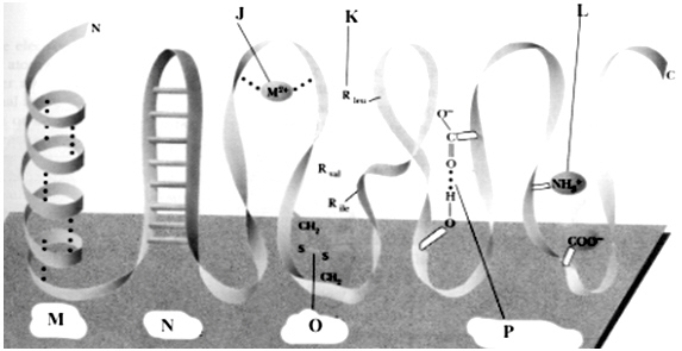 Refer to Exhibit 4B.Which one shows covalent bonding of R-groups?
Refer to Exhibit 4B.Which one shows covalent bonding of R-groups?
A) K
B) L
C) O
D) K and L
E) All of these
 Refer to Exhibit 4B.Which one shows covalent bonding of R-groups?
Refer to Exhibit 4B.Which one shows covalent bonding of R-groups?A) K
B) L
C) O
D) K and L
E) All of these

Unlock Deck
Unlock for access to all 77 flashcards in this deck.
Unlock Deck
k this deck
60
Heme would best be described as a
A) motif.
B) domain.
C) prosthetic group.
D) helix.
A) motif.
B) domain.
C) prosthetic group.
D) helix.

Unlock Deck
Unlock for access to all 77 flashcards in this deck.
Unlock Deck
k this deck
61
Variations in the structure of hemoglobin
A) do not always have an adverse effect on health
B) can alter the binding of heme to the protein
C) can occur on the surface of the protein
D) all of these
A) do not always have an adverse effect on health
B) can alter the binding of heme to the protein
C) can occur on the surface of the protein
D) all of these

Unlock Deck
Unlock for access to all 77 flashcards in this deck.
Unlock Deck
k this deck
62
The oxygen binding curve of which of the following is the closest to that of myoglobin?
A) hemoglobin at pH 6.8
B) hemoglobin that lacks BPG
C) maternal hemoglobin
D) fetal hemoglobin
A) hemoglobin at pH 6.8
B) hemoglobin that lacks BPG
C) maternal hemoglobin
D) fetal hemoglobin

Unlock Deck
Unlock for access to all 77 flashcards in this deck.
Unlock Deck
k this deck
63
Which of the following proteins is not homologous with the others?
A) myoglogin
B) a-chain of hemoglobin
C) b-chain of hemoglobin
D) collagen
A) myoglogin
B) a-chain of hemoglobin
C) b-chain of hemoglobin
D) collagen

Unlock Deck
Unlock for access to all 77 flashcards in this deck.
Unlock Deck
k this deck
64
The information needed for the structure of a protein is contained in
A) amino acid composition
B) primary structure
C) secondary structure
D) tertiary structure
A) amino acid composition
B) primary structure
C) secondary structure
D) tertiary structure

Unlock Deck
Unlock for access to all 77 flashcards in this deck.
Unlock Deck
k this deck
65
What is the major force that drives nonpolar substances out of aqueous solution?
A) Increased enthalpy of hydrophobic bonds formed between solute molecules.
B) Decreased entropy of newly organized solute molecules.
C) Increased entropy of newly organized solute molecules.
D) Increased enthalpy of H-bonds in the solvent water.
E) Increased entropy of solvent water molecules.
A) Increased enthalpy of hydrophobic bonds formed between solute molecules.
B) Decreased entropy of newly organized solute molecules.
C) Increased entropy of newly organized solute molecules.
D) Increased enthalpy of H-bonds in the solvent water.
E) Increased entropy of solvent water molecules.

Unlock Deck
Unlock for access to all 77 flashcards in this deck.
Unlock Deck
k this deck
66
The affinity of fetal hemoglobin for oxygen
A) has not been studied
B) is the same as that of adult hemoglobin
C) is lower than that of maternal hemoglobin
D) is higher than that of maternal hemoglobin
A) has not been studied
B) is the same as that of adult hemoglobin
C) is lower than that of maternal hemoglobin
D) is higher than that of maternal hemoglobin

Unlock Deck
Unlock for access to all 77 flashcards in this deck.
Unlock Deck
k this deck
67
In sickle-cell anemia hemoglobin
A) the four subunits of hemoglobin dissociate from one another
B) the heme group is lost from all subunits
C) the iron is in the Fe(III) form rather than the normal Fe(II)
D) groups of hemoglobin molecules aggregate with each other
A) the four subunits of hemoglobin dissociate from one another
B) the heme group is lost from all subunits
C) the iron is in the Fe(III) form rather than the normal Fe(II)
D) groups of hemoglobin molecules aggregate with each other

Unlock Deck
Unlock for access to all 77 flashcards in this deck.
Unlock Deck
k this deck
68
In allosteric interactions
A) proteins that consist of a single polypeptide chain form aggregates.
B) disulfide bonds are broken.
C) changes that take place in one site of a protein cause changes at a distant site.
D) metal ions always bind to the protein.
A) proteins that consist of a single polypeptide chain form aggregates.
B) disulfide bonds are broken.
C) changes that take place in one site of a protein cause changes at a distant site.
D) metal ions always bind to the protein.

Unlock Deck
Unlock for access to all 77 flashcards in this deck.
Unlock Deck
k this deck
69
The following amino acid causes a kink or bend in the a-helix.
A) Ala
B) Glu
C) Lys
D) Pro
E) Trp
A) Ala
B) Glu
C) Lys
D) Pro
E) Trp

Unlock Deck
Unlock for access to all 77 flashcards in this deck.
Unlock Deck
k this deck
70
Hemoglobin differs from myoglobin because
A) it does not have a heme group.
B) it is a tetramer, whereas myoglobin is a single polypeptide chain.
C) it does not contain any helical regions.
D) it contains more b-pleated sheet structure.
A) it does not have a heme group.
B) it is a tetramer, whereas myoglobin is a single polypeptide chain.
C) it does not contain any helical regions.
D) it contains more b-pleated sheet structure.

Unlock Deck
Unlock for access to all 77 flashcards in this deck.
Unlock Deck
k this deck
71
Hydrophobic interactions may occur between the R groups of which of the following amino acids?
A) tyrosine and glycine
B) arginine and histidine
C) phenylalanine and tryptophan
D) valine and asparagine
A) tyrosine and glycine
B) arginine and histidine
C) phenylalanine and tryptophan
D) valine and asparagine

Unlock Deck
Unlock for access to all 77 flashcards in this deck.
Unlock Deck
k this deck
72
In the Bohr effect the binding of oxygen to hemoglobin
A) is increased by the presence of Na+
B) is increased by the presence of H+ and CO2
C) is decreased by the presence of H+ and CO2
D) is unchanged
A) is increased by the presence of Na+
B) is increased by the presence of H+ and CO2
C) is decreased by the presence of H+ and CO2
D) is unchanged

Unlock Deck
Unlock for access to all 77 flashcards in this deck.
Unlock Deck
k this deck
73
The binding of oxygen to hemoglobin differs from the oxygen-binding behavior of myoglobin because
A) oxygen binding to hemoglobin is cooperative.
B) oxygen binding to myoglobin is cooperative.
C) hemoglobin is not an allosteric protein.
D) the oxygen-binding curve of hemoglobin is hyperbolic.
A) oxygen binding to hemoglobin is cooperative.
B) oxygen binding to myoglobin is cooperative.
C) hemoglobin is not an allosteric protein.
D) the oxygen-binding curve of hemoglobin is hyperbolic.

Unlock Deck
Unlock for access to all 77 flashcards in this deck.
Unlock Deck
k this deck
74
Proteins that aid in the correct and timely folding of other proteins are called
A) motifs.
B) chaperones.
C) liposomes.
D) cooperative.
A) motifs.
B) chaperones.
C) liposomes.
D) cooperative.

Unlock Deck
Unlock for access to all 77 flashcards in this deck.
Unlock Deck
k this deck
75
Incorrect protein folding resulting in exposure of hydrophobic regions can result in
A) aggregation.
B) homology.
C) liposomes.
D) the Bohr effect.
A) aggregation.
B) homology.
C) liposomes.
D) the Bohr effect.

Unlock Deck
Unlock for access to all 77 flashcards in this deck.
Unlock Deck
k this deck
76
The Bohr effect for oxygen binding states that
A) Mb binds oxygen more tightly than Hb.
B) Hb will bind oxygen very tightly when the CO2 concentration is high.
C) as the pH goes down, Hb binds oxygen less tightly.
D) Hb's ability to bind oxygen increases with higher oxygen concentration.
A) Mb binds oxygen more tightly than Hb.
B) Hb will bind oxygen very tightly when the CO2 concentration is high.
C) as the pH goes down, Hb binds oxygen less tightly.
D) Hb's ability to bind oxygen increases with higher oxygen concentration.

Unlock Deck
Unlock for access to all 77 flashcards in this deck.
Unlock Deck
k this deck
77
Which of the following best describes what happens when hemoglobin binds bisphosphoglyceric acid (BPG)?
A) Binding of BPG leads to tighter binding of oxygen.
B) Binding of BPG allows maternal (adult) Hb to bind oxygen more tightly than fetal Hb.
C) Binding of BPG causes oxygen to dissociate from Hb.
D) Binding of BPG causes the subunits of hemoglobin to separate.
A) Binding of BPG leads to tighter binding of oxygen.
B) Binding of BPG allows maternal (adult) Hb to bind oxygen more tightly than fetal Hb.
C) Binding of BPG causes oxygen to dissociate from Hb.
D) Binding of BPG causes the subunits of hemoglobin to separate.

Unlock Deck
Unlock for access to all 77 flashcards in this deck.
Unlock Deck
k this deck



